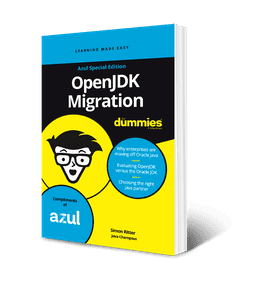The entire Java ecosystem has been going through a lot of turmoil with a shortened release cycle combined with continual and significant Java licensing changes.
This opens up a number of questions, such as:
- Do we really need to update Java to the latest releases?
- When is the best time to update?
- To which version should be updated?
- How would updating affect our existing applications?
- What would be the total cost of updating?
- What are the risks of not updating and simply sticking with what works?
- Which provider and distribution to use, since there are many and many users are not aware of the differences between them?
There are no simple answers to any of these questions, which can turn out to be business-critical.
The recently published book OpenJDK Migration for Dummies provides a clear path to get answers to these and many other related questions, which are essential for survival in this new era of Java.
It is written by Java Champion Simon Ritter who has many years of deep technical expertise on all aspects of the JVM, and their impact on business.
The book is structured into seven chapters which provide meaningful context without heavy technical jargon, and guides readers through preparation, migrating applications, understanding of benefits, and evaluating various Open JDK distributions and providers.
It covers the main pain points of migration to OpenJDK from the developer and DevOps perspective, such as:
- Will I lose functionality if I switch?
- What’s the risk of a performance regression?
- Will I need to move to the latest Java version?
- Will I need to recompile my application? – Will I need to rewrite or modify my application code?
In addition, it helps with understanding the main performance and security aspects of JVM in appendices. For example, Appendix B provides a concise explanation of critical JVM components, such as the garbage collector and JIT compiler, as well as why and how they affect performance. Also, the book handles how these components have evolved over time and how they are continually being enhanced to make Java even faster and even more reliable.
Overall, not only does the book answer common questions, and demystifies Java technical jargon (TCK, GC, JIT), but it also provides insights on how to get the best out of Java.
And since all this is coming from an expert from the company whose customers include 35% of Fortune 100, 50% of the Forbes Top-Ten World’s Most Valuable Brands, and all ten of the world’s top-ten financial trading companies, it is an extremely valuable resource for understanding modern Java, and for staying on the edge of Java innovation.
Get it free at https://www.azul.com/openjdk-








